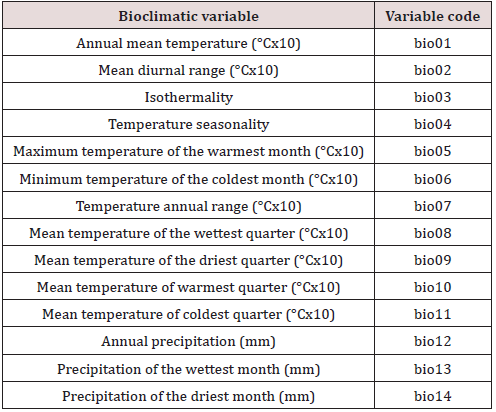
Lupine Publishers Group
Lupine Publishers
Menu
ISSN: 2637-4676
Research Article(ISSN: 2637-4676) 
A Bioclimate-Based Maximum Entropy Model for ComperiellacalauanicaBarrion, Almarinez & Amalin (Hymenoptera: Encyrtidae), Parasitoid of Aspidiotusrigidus Reyne, in the Philippines Volume 8 - Issue 4
Billy Joel M Almarinez1,2*, Mary Jane A Fadri3, Richard Lasina4, Thaddeus M Carvajal1,2,5, Kozo Watanabe1,2,5, Mary Angelique A Tavera1,2, Jesusa C Legaspi6 and Divina M Amalin1,2
- 1Center for Natural Science and Environmental Research, De La Salle University, Philippines
- 2Biology Department, De La Salle University, Philippines
- 3Biology Department, Romblon State University, Philippines
- 4Philippine Coconut Authority-Zamboanga Research Center, Philippines
- 5Department of Civil and Environmental Engineering, Ehime University, Matsuyama, Japan
- 6Center for Medical, Agricultural and Veterinary Entomology, Department of Agriculture-Agricultural Research Service, USA
Received: June 15, 2020; Published: June 26, 2020
Corresponding author: Billy Joel M Almarinez, Biological Control Research Unit, Center for Natural Science and Environmental Research, De La Salle University, Taft Avenue, Manila, Philippines
DOI: 10.32474/CIACR.2020.08.000296
Abstract
Background:Comperiellacalauanica Barrion, Almarinez & Amalin (Hymenoptera: Encyrtidae) is a host-specific endoparasitoid and effective biological control agent of Aspidiotus rigidus Reyne (Hemiptera: Diaspididae), whose outbreak in 2010 to 2015 severely threatened the coconut industry in the Philippines. Using the maximum entropy (MaxEnt) algorithm, we developed a Species Distribution Model (SDM) for calauanica based on 19 bioclimatic variables, using occurrence data obtained mostly from field surveys conducted in A. rigidus-infested areas in Luzon Island from 2014 to 2016.
Results: The calculated AUC values for the model were very high (0.966, standard deviation=0.005), indicating the model’s high predictive power. Precipitation seasonality was found to have the highest relative contribution to model development. Response curves produced by MaxEnt suggested the positive influence of mean temperature of the driest quarter, and negative influence of precipitation of the driest and coldest quarters on habitat suitability.
Conclusion: Given that calauanicahas been found to always occur with A. rigidus in Luzon Island due to high host-specificity, the SDM for the parasitoid may also be considered and used as a predictive model for its host. This was confirmed through field surveys conducted between late 2016 and early 2018, which found and confirmed the occurrence of A. rigidusin three areas predicted by the SDM to have moderate to high habitat suitability or probability of occurrence of C. calauanica: Zamboanga City in Mindanao; Isabela City in Basilan Island; and Tablas Island in Romblon. This validation in the field demonstrated the utility of the bioclimate-based SDM for C. calauanicain predicting habitat suitability or probability of occurrence of A. rigidus in the Philippines.
Keywords: Maximum Entropy; Species Distribution Modeling; Comperiella Calauanica; Aspidiotus Rigidus; Pest Invasion Forecasting
Introduction
The Philippines is a primarily agricultural nation in
Southeast Asia, despite rapid industrialization in many areas of
the archipelago. Statistics in 2015 indicate that 29.15% of total
employment in the Philippines is in agriculture [1]. The agricultural
sector has provided the fourth highest contribution to the country’s
Gross Domestic Product (GDP), with the latest data summarized by
the Philippine National Statistics Coordination Board indicating
GDP from agriculture at 53.7 billion Philippine pesos (equivalent
to about 1 billion US dollars). Coconut is one of the high value
commercial crops of the country and has been recognized for
years as a top agricultural export [2]. However, production of this
crop was severely threatened by an outbreak of the destructive
coconut scale, Aspidiotus rigidus Reyne (Hemiptera: Diaspididae),
which devastated plantations in the Southern Tagalog region of
Luzon Island from 2010 to 2015. Feeding of this diaspidid on the
foliage of coconut palms has been found to impair photosynthesis,
consequently affecting flowering, fruiting, and even compromising
the survival of the infested tree [3]. A native parasitic wasp
belonging to genus Comperiella Howard (Hymenoptera: Encyrtidae)
was subsequently discovered and was found to be highly and very
specifically parasitizing A. rigidus in the outbreak areas from 2014
onwards. Preliminary findings and observations from field and
laboratory studies suggested the potential of the parasitoid for
biological control [4]. Additionally, the encyrtid was not only the first
native record in the Philippines for its genus, but was also described
as a new species, C. calauanica Barrion, Almarinez & Amalin [5]. C.
calauanica has been found to be very specific to A. rigidus, although
mathematical modeling and simulations by [6] assumed that the
parasitoid may exhibit Holling type III functional response in which
parasitization on an alternate host is necessary for survival in the
absence of the primary host. Predictive geographical modeling that
is based on the dependence of species and community distributions
on environmental factors has been viewed as an important means
to assess the impact of natural and anthropogenic environmental
change on the distribution of organisms [7]. Climate-based
ecological models can help in conservation efforts by providing
information for resource and habitat management [8]. Among the
popular algorithms used in modeling species distributions is the
maximum entropy (MaxEnt) approach, which requires presenceonly
data as an indication of the species’ occurrence.
Models produced using MaxEnt can be easily understood and
interpreted and provide valuable insights on distribution and
habitat suitability for a species [9,10]. MaxEnt modeling has been
used to predict the current and potential distributions of invasive
species [11], as well as those of a variety of forest and agricultural
insect pests which include: the large pine weevil, Hylobius abietis
L., and the horse-chestnut leaf miner, Cameraria ohridella Deschka
and Dimič [12], and six tephritid fruit flies [13] in Europe; three
species of tephritid flies under genus Dacus Fabricius [14] and the
European grapevine moth, Lobesia botrana Denis & Schiffermüller,
in China [15]; the ricaniid planthopper, Ricania shantungensis
Chou & Lu in Korea [16,17]; and the cotton mealybug, Phenacoccus
solenopsis Tinsley, in India [18] and worldwide [19]. The use
of MaxEnt modeling as a tool in integrated pest management,
particularly in forecasting potential areas of new pest invasion
relative to climate, has not yet been explored very well in the
Philippines. Hence, in view of the use of C. calauanica for biological
control of A. rigidus, the MaxEnt approach was employed in this
study to generate a bioclimate-based Species Distribution Model
(SDM) for the prediction of either the presence of the parasitoid
or suitability of areas for its occurrence. This study provides a peer
into the potential of bioclimate-based SDMs as tools for integrated
pest management, especially in view of climate change. The ability
and utility of the distribution model of a highly specific parasitoid
to predict the potential distribution or areas of new invasion by its
host are likewise demonstrated.
Materials and Methods
Species presence, Bioclimatic variables, and Other data
Presence-only data pertaining to occurrence of C. calauanica were derived from GPS coordinates recorded from periodic field surveys conducted from April 2014 to June 2016 in 15 sampling points across three provinces (Batangas, Cavite, and Laguna) in the Southern Tagalog region, and in 4 points in the town of Orani in Bataan in the Central region of Luzon Island Table 1. An additional coordinate was derived using Google Maps (accessible from http:// maps.google.com) to represent a point in Isabela City, Basilan Island where sightings of C. calauanica were reported in January 2016 but was not actually covered by our surveys. The occurrence points were encoded in spreadsheet form (with three columns for species, longitude, and latitude in that order) using Microsoft Excel and saved as a Comma-Separated Values (CSV) file. Bioclimatic data sets were downloaded from the WorldClim Global Climate Database (accessible from http://worldclim.org/current). These bioclimatic data were derived from global climate data interpolated by [20] and represent current conditions. The downloaded raster data sets, in BIL format with 30 arc-seconds resolution, pertain to 19 variables Table 2. For visualization of the SDM and subsequent map construction, vector layers (in SHP format) of the administrative boundaries of the Philippines were directly downloaded from the Philippine GIS Data Clearinghouse (accessible from http://www. philgis.org).
Table 1: Points with confirmed occurrence of Comperiella calauanica from April 2014 to January 2016.

*Not covered by surveys in the current study.
Species distribution modeling using MaxEnt
Maximum Entropy Species Distribution Modeling (MaxEnt) Version 3.3.3k was used to develop the SDM for C. calauanica. The presence-only data encoded in CSV served as the sample, while the downloaded bioclimatic data sets in BIL format were used as the environmental layers for model construction. Among the 20 presence records inputted into the algorithm, 18 were used for model training while 13 were used for model testing. Iterations of the optimization algorithm were set to 5000, and Jackknife test was included in the algorithm to provide a measurement of the importance of each bioclimatic variable in the model. Response curves were also generated for assessment of the variables. Two runs of the same model were done so that the first output was set to express values logistically and the second with values set to raw. The HTML outputs were later viewed through Internet Explorer 11, while the outputs in raster form (in ASC format) were visualized, enhanced, and assessed in combination with other geospatial datasets through Quantum GIS (QGIS) Versions 1.8.0 and 3.6.0.
Analysis and assessment of the species distribution model
The constructed MaxEnt model was evaluated using the result of the Receiver Operating Characteristic (ROC) analysis, with the obtained values for the area under the ROC curve (AUC) serving as a measure of model performance. AUC values closer to 1.0 indicate better model performance compared to those further from 1.0. The testing AUC is considered as the true indicator of the predictive power of the model [9,10]. The bioclimatic variable with the highest percentage contribution to the construction of the model was likewise noted. To infer which among the bioclimatic variables the species appear to respond most positively (i.e., preferred conditions) and to which they respond most negatively (i.e., conditions to which they appear to be most sensitive to) in terms of their occurrence, the trends shown in the response curves of a model were examined and compared with each other. Variables whose response curves showed a clearly unidirectional upward or downward trend were those with putatively greatest impact on potential distribution.
Validation of predicted distribution
A field survey for A. rigidus surveillance was conducted in Zamboanga City and in Isabela City in Basilan Island in Western Mindanao initially from 2016 to 2018 Subsequent surveys were done in late January to early February 2017 for field release of mass-reared C. calauanica, and in April 2017 for monitoring of establishment and spread of the parasitoids. Field surveillance was also conducted in Tablas Island in the province of Romblon in January 2018 for confirmation of received verbal reports of A. rigidus infestation. GPS coordinates of points where A. rigidus infestations were confirmed were recorded and encoded in a CSV file for overlaying of these points on the map with the C. calauanica SDM in QGIS. Coincidence of points with areas predicted by the SDM to have non-zero probability (or at least low-moderate suitability) was considered validation of the prediction of occurrence.
Results and Discussion
MaxEnt species distribution model for Comperiella calauanica
The generated bioclimate-based distribution model for C. calauanica Figure 1 predicts hotspot areas in the provinces of Southern Luzon where the outbreak of A. rigidus between 2010 and 2015 most heavily devastated coconut plantations and stands: Batangas, Cavite, and Laguna. It additionally predicts hotspots in the province of Bataan in Central Luzon. These predicted hotspots were expected since all the survey points in the study, and which were inputted into the modeling algorithm, were in those provinces. Areas with non-zero habitat suitability were nonetheless predicted in other parts of the Philippine archipelago that were outside the range of the survey points. Although the model in raw expression Figure 1B shows predictions of moderate to high habitat suitability throughout almost the entire archipelago, areas whose predicted probabilities may be considered substantial (between “low-moderate” and “high”) consistent with the logistic expression Figure 1A include: several other parts of Luzon mainland; other islands in the Luzon island group, notably Mindoro, Palawan, Marinduque, Romblon, and Masbate; Panay Island; Negros Island; Cebu; Bohol; several parts of Mindanao mainland; Basilan Island; and Sulu. It should be noted that raw values tend to be significantly lower than their logistic equivalent. Given the spectral scale for qualitative interpretation of colors on the SDM, the predicted probability value for a given point could be considered “high” when expressed as raw, but only “moderate” when logistically expressed. This would explain the apparent spectral discrepancy between the raw and logistic expressions of the same SDM. Nevertheless, areas with “low” to “moderate” predicted probability (or habitat suitability) should be treated as potential areas for population establishment, especially if preferable environmental conditions beyond bioclimate (e.g. presence of hosts) may occur in such areas.The SDM was developed for C. calauanica, which has been found to be very specific to its diaspidid host, A. rigidus. Although recent mathematical modeling with simulations assumed Holling type III functional response [6] which would require C. calauanicato parasitize an alternate host in the absence of A. rigidus, such alternate host has not been found and the parasitoid is so far known to parasitize only A. rigidus. Hence, it is reasonable to view MaxEnt SDM for C. calauanicaas a predictive model that may also apply to its primary host, especially in view of the confirmed occurrence of A. rigidusin all of the 20 points that served as input to the modeling algorithm Figure 1.A. rigidus without C. calauanicawas confirmed in Zamboanga City Figure 2A-B and in Tablas Island Figure 2E-F, whereas C. calauanicawas confirmed to parasitize A. rigidusin Isabela City Figure 2C-D. The infestation in Zamboanga City at the time of the initial surveillance was not yet at the outbreak level, whereas an outbreak appeared to have already started in Tablas Island by the time surveillance under this study was carried out.
Figure 1: Bioclimate-based SDM for Comperiella calauanica in logistic (A) and raw (B) expressions of calculated probabilities. Warmth of color indicates relative probability of occurrence or suitability of habitat.
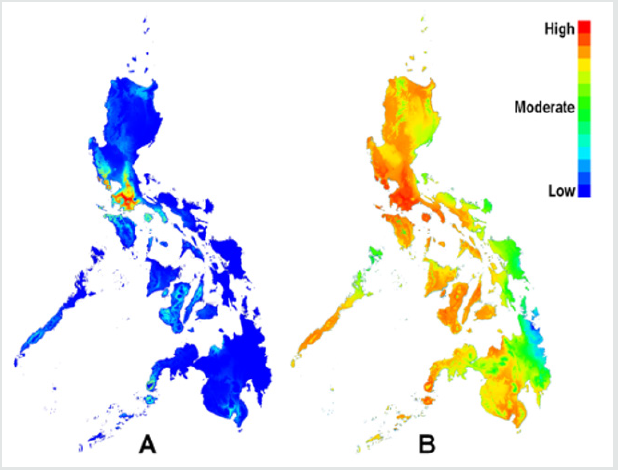
Figure 2: Response (probability of presence) of Comperiella calauanica to selected bioclimatic variables: (A) mean temperature of the driest quarter; (B) precipitation of the driest quarter; and (C) precipitation of the coldest quarter.
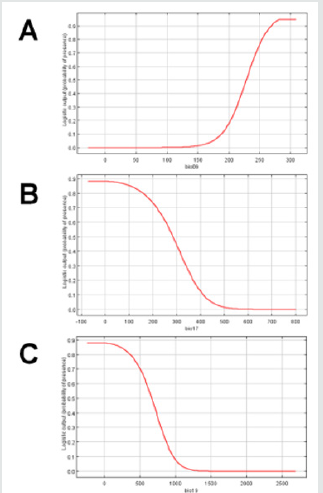
Model Performance and Contribution of Bioclimatic Variables
The training AUC value of the C. calauanica SDM was 0.996, and the test AUC value was 0.966 (standard deviation=0.005). Both values are higher than 0.8, the value above which the AUC must be for the predictive ability of the model to be considered “convincing [21]. The C. calauanicaSDM, therefore, has very high predictive power based on these AUC values. Precipitation seasonality (bio15) was the variable found to have the highest relative contribution in the development of the model at 51.5%. This suggests that distribution of C.calauanicamay be influenced more by precipitation than by temperature, especially considering that the Philippines is a tropical country, where temperatures throughout the year tend to vary less than in temperate regions. In comparison, variables pertaining to temperature or its variations were found to have significant influence on the predicted distributions of insect pest species in temperate regions, namely Dacusspp. [14] and Lobesia botrana [15] in China, Ricania shantungensis in Korea [17], Hylobius abietisand Cameraria ohridellain Europe [12], and six species of tephritid fruit flies in Europe [13].Three bioclimatic variables were found to have clear unidirectional upward or downward trends, and therefore potentially having the greatest impact on occurrence Figure 3. Response curves for these variables indicate that the probability of occurrence of C. calauanica increases with higher mean temperatures of the driest quarter and decreasing with higher precipitation during the driest and during the coldest quarters of the year. These findings suggest that the parasitoid could be sensitive to precipitation and may find habitats with higher mean temperatures and relatively less precipitation to be more suitable. Furthermore, it could be noted in the set of response curves that the predicted probability of occurrence remained constant across changes in variables pertaining to temperature more than precipitation, namely annual mean temperature (bio01), maximum temperature of the warmest month (bio05), minimum temperature of the coldest month (bio06), and mean temperature of the warmest quarter (bio10). If these response curves provide an approximation of the actual ecophysiological responses of C. calauanica, then it is possible that habitat suitability for either insect may be influenced more by precipitation than by temperature.
Figure 3: MaxEnt SDM of Comperiella calauanica, with areas in Romblon (A) and Western Mindanao (B) where infestations of Aspidiotus rigidus had been confirmed. Red stars mark the points where confirmatory surveys were conducted between November 2016 and January 2017.
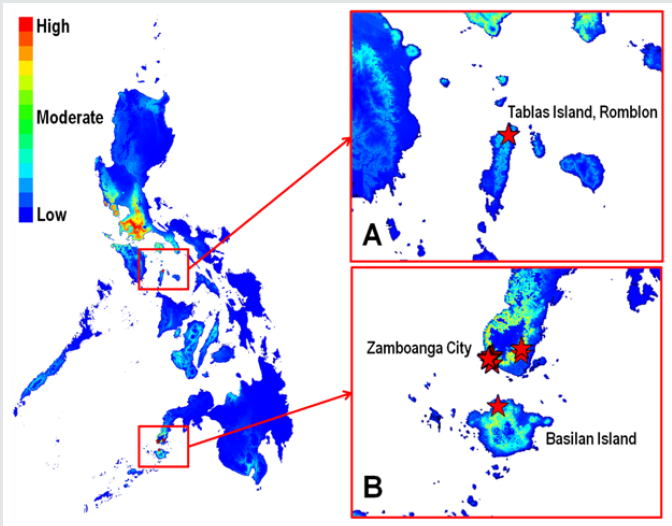
Confirmation of Occurrences Predicted by the MaxEnt Model
The MaxEnt SDM predicted moderate to high habitat suitability in areas outside the previously known and reported A. rigidus-infested areas in Luzon (Southern Tagalog region and Orani, Bataan) and in Basilan Island in Mindanao. These areas include Zamboanga City and Romblon. Field surveillance confirmed the occurrence of A. rigidus in Zamboanga City, in Isabela City in Basilan Island, and in Tablas Island, Romblon Figure 4.Presence points used in development of the C. calauanicaSDM were limited only to the known outbreak and infestation areas from 2014 to early 2016, and were limited to only 20 points, including one that was derived from Google Maps. Findings from field surveys conducted in late 2016 up to 2018 validated these predictions, consistent with the high predictive power of the SDM as indicated by the high training and test AUC values computed by MaxEnt. Previously reported MaxEnt models for other insect species were developed using between twice to more than thirty times as many occurrence records Table3. Nevertheless, the SDM developed for C. calauanica using relatively few points was able to correctly predict the occurrence of A. rigidus in Zamboanga City and in Romblon, and together with the parasitoid in Basilan Island. MaxEnt has been recognized for being much less sensitive to sample size compared to other distribution modeling algorithms, capable of being able to produce useful, predictive models with as small as 5 occurrence points [22,23]. To date and to our knowledge, this is the first field-based validation of the occurrence or habitat suitability predicted by MaxEnt SDM for an insect species that is important to agriculture or forestry.
Figure 4: Aspidiotus rigidus-infested coconut trees with magnified view of scale colony samples from: Zamboanga City (A and B); Isabela City, Basilan (C and D); and Tablas Island, Romblon (E and F). Black arrows point to the characteristic distribution of eggs and egg skins along the pygidial ends of mature female A. rigidus which can be used as basis to quickly distinguish this species from other Aspidiotus spp. on coconut. White double arrow points to female Comperiella calauanica. Scale bars on the photomicrographs approximate 1.0mm.
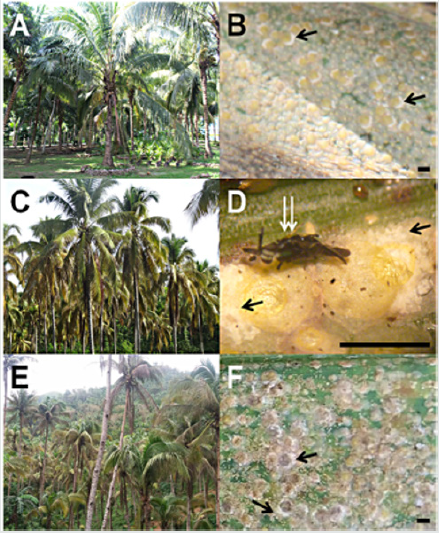
Table 3: Number of occurrence points used for MaxEnt modeling of selected insect species with respective test AUC values.
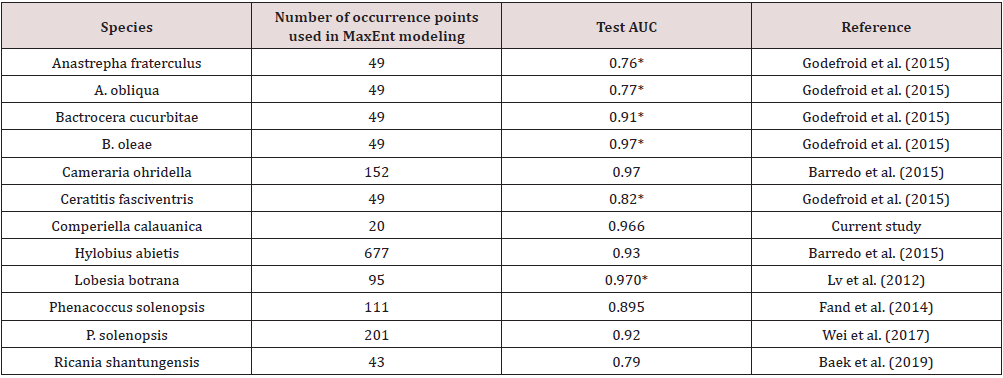
*Not indicated if AUC value refers to test AUC or training AUC.
Conclusion
MaxEnt was used to develop a bioclimate-based SDM for C. calauanica, the highly specific endoparasitoid of the destructive coconut scale, A. rigidus, in the Philippines. The SDM predicted moderate to high habitat suitability in areas in Luzon Island as well as in other parts of the archipelago. Some of the hotspots were predicted in areas that were not covered by field surveillance in 2014 to 2016, through which the limited number of occurrence points used in model development were obtained. Despite the relatively small sample size used for model development, the SDM was determined to have an excellent predictive power as indicated by the very high training and test AUC values computed by MaxEnt. Field surveys conducted in late 2016 to early 2017 confirmed the occurrence of A. rigidus in Zamboanga City, as well as in Isabela City in Basilan Island in Western Mindanao, where the SDM predicted hotspot areas. Subsequently, A. rigidus was also confirmed through field surveillance in Tablas Island in Romblon, where moderate to high habitat suitability was also predicted. These findings point to the utility of the C. calauanicaSDM in predicting habitat suitability or probability of occurrence of the coconut pest which caused a devastating outbreak in the Southern Tagalog region of Luzon Island from 2010 to 2015. This study has demonstrated how bioclimate-based modeling may have considerable potential as a tool for pest invasion forecasting and surveillance. Modeling based not only on current conditions but also on projected future conditions should be considered and further assessed.MaxEnt modeling was also able to provide insights into possible responses of C. calauanica or A. rigidus to climatic factors, particularly precipitation. We recommend that controlled assessments be done to determine the ecophysiological responses of either C. calauanica or A. rigidus to such climatic factors and verify the MaxEnt-predicted responses. Sufficient understanding of the ecophysiology of insects, supplemented by valuable information that can be provided by bioclimate-based SDMs, may help in the development of pest invasion risk maps, not only for A. rigidus but also for other species of importance to agriculture or forestry in the Philippines, especially in view of climate change.
Acknowledgement
This study was funded by the Philippine Council for Agricultural, Aquatic, and Natural Resources Research and Development (PCAARRD) of the Philippine Department of Science and Technology (DOST). We also express our sincerest gratitude to Dr. Ramon L. Rivera, Center Manager of the Philippine Coconut Authority- Zamboanga Research Center (PCA-ZRC), and Mario V. Navasero and Marcela M. Navasero of the National Crop Protection Center (NCPC).
Conflict of Interest
The authors declare no conflict of interest.
References
- World Bank (2017) Employment in agriculture (% of total employment, Philippines).
- Philippine Statistics Authority (2016) Selected Statistics on Agriculture 2016.
- Watson GW, Adalla CB, Shepard BM, Carner GR (2015) Aspidiotus rigidus Reyne (Hemiptera: Diaspididae): A devastating pest of co-conut in the Philippines. Agricultural and Forest Entomology 17(1): 1-8.
- Almarinez BJM, Amalin DM, Carandang JSR, Navasero MV, Navasero MM (2015) First Philippine record of the parasitoid, Comperiella sp. (Hymenoptera: Encyrtidae): A potential biocontrol agent against Aspidiotus rigidus (Hemiptera: Diaspididae). Journal of Applied Entomology 139: 237-240.
- Barrion AT, Almarinez BJM, Amalin DM, Carandang JSR (2016)Comperiella calauanica n. (Hymenoptera: Encyrtidae), an endoparasitoid of the invasive coconut scale, Aspidiotus rigidus Reyne (Hemiptera: Diaspididae) on Luzon Island, Philippines. Asia Life Sciences 25(1): 1-16.
- Palen DI, Almarinez BJM, Amalin DM, Legaspi JC, David G (2019) A Host-Parasitoid Model for Aspidiotus rigidus (Hemiptera: Diaspididae) and Comperiella calauanica (Hymenoptera: Encyrtidae). Environmental Entomology 48(1): 134-140.
- Guisan A, Zimmermann NE (2000) Predictive habitat distribution models in ecology. Ecological Modelling 135: 147-186.
- Schwartz MW (2012) Using niche models with climate projections to inform conservation management decisions. Biological Conservation 155: 149-156.
- Phillips SJ, Anderson RP, Schapire RE (2006) Maximum entropy modeling of species geographic distributions. Ecological Modelling 190(3-4): 231-259.
- Phillips SJ, Dudik M, Schapire RE (2004) A maximum entropy approach to species distribution modeling. Proceedings of the Twenty-First International Conference on Machine Learning pp: 655-662.
- Gormley AM, Forsyth DM, Griffioen P, Lindeman M, Ramsey DSL, et al. (2011) Using presence-only and presence-absence data to estimate the current and potential distributions of established invasive species. Journal of Applied Ecology 48(1): 25-34.
- JI Barredo, G Strona, D de Rigo, G Caudullo, G Stancanelli, et al. (2015) Assessing the potential distribution of insect pests: case studies on the large pine weevil (Hylobius abietis L) and horse-chestnut leaf miner (Cameraria ohridella) under present and future climate conditionsin European forests. EPPO Bulletin 45(2): 273-281.
- Godefroid M, Cruaud A, Rossi JP, Rasplus JY (2015) Assessing the risk of invasion by tephritid fruit flies: Intraspecific divergence matters. PLoS ONE 10(8).
- Li B, Wei W, Ma J, Zhang R (2009) Maximum entropy niche-based modeling (Maxent) of potential geographical distributions of fruit flies Dacus bivittatus, ciliatus and D. vertebrates (Diptera: Tephritidae). Acta Entomologica Sinica 52(10): 1122-1131.
- Lv W, Li Z, Wu X, Ni W, Qv W (2011) Maximum entropy niche-based modeling (Maxent) of potential geographical distributions of Lobesia botrana (Lepidoptera: Tortricidae) in China. In: Li D, Chen Y (Eds). Computer and Computing Technologies in Agriculture V. CCTA 2011. IFIP Advances in Information and Communication Technology pp: 239-246.
- Kim D, Lee H, Kim M, Lee D (2015) Predicting the potential habitat, host plants, and geographical distribution of Pochazia shantungensis (Hemiptera: Ricaniidae) in Korea. Korean Journal of Applied Entomology 54(3): 179-189.
- Baek S, Kim M, Lee J (2019) Current and future distribution of Ricania shantungensis (Hemiptera: Ricaniidae) in Korea: Application of spatial analysis to select relevant environmental variables for MaxEnt and CLIMEX modeling. Forests 10: 490.
- Fand BB, Kumar M, Kamble AL (2014) Predicting the potential geographic distribution of cotton Mealybug Phenacoccus Solenopsisin India based on MAXENT ecological niche model. Journal of Environmental Biology 35(5): 973-982.
- Wei J, Zhang H, Zhao W, Zhao Q (2017) Niche shifts and the potential distribution of Phenacoccus solenopsis (Hemiptera: Pseudococcidae) under climate change. PLoS ONE 12(7).
- Hijmans RJ, Cameron SE, Parra JL, Jones PG, Jarvis A (2005) Very high-resolution interpolated climate surfaces for global land areas. International Journal of Climatology 25: 1965-1978.
- Byeon D, Jung S, Lee WH (2018) Review of CLIMEX and MaxEnt for studying species distribution in South Korea. Journal of Asia-Pacific Biodiversity 11(3): 325-333.
- Wisz MS, Hijmans RJ, Li J, Peterson AT, Graham CH, et al. (2008) NCEAS Predicting Species Distributions Working GroupEffects of sample size on the performance of species distribution models. Diversity and Distributions 14: 763-773.
- Hernandez PA, Graham CH, Master LL, Albert DL (2006) The effect of sample size and species characteristics on performance of different species distribution modeling methods. Ecography 29(5): 773-785.

Top Editors
-

Mark E Smith
Bio chemistry
University of Texas Medical Branch, USA -

Lawrence A Presley
Department of Criminal Justice
Liberty University, USA -

Thomas W Miller
Department of Psychiatry
University of Kentucky, USA -

Gjumrakch Aliev
Department of Medicine
Gally International Biomedical Research & Consulting LLC, USA -

Christopher Bryant
Department of Urbanisation and Agricultural
Montreal university, USA -

Robert William Frare
Oral & Maxillofacial Pathology
New York University, USA -

Rudolph Modesto Navari
Gastroenterology and Hepatology
University of Alabama, UK -

Andrew Hague
Department of Medicine
Universities of Bradford, UK -

George Gregory Buttigieg
Maltese College of Obstetrics and Gynaecology, Europe -

Chen-Hsiung Yeh
Oncology
Circulogene Theranostics, England -
.png)
Emilio Bucio-Carrillo
Radiation Chemistry
National University of Mexico, USA -
.jpg)
Casey J Grenier
Analytical Chemistry
Wentworth Institute of Technology, USA -
Hany Atalah
Minimally Invasive Surgery
Mercer University school of Medicine, USA -

Abu-Hussein Muhamad
Pediatric Dentistry
University of Athens , Greece

The annual scholar awards from Lupine Publishers honor a selected number Read More...




